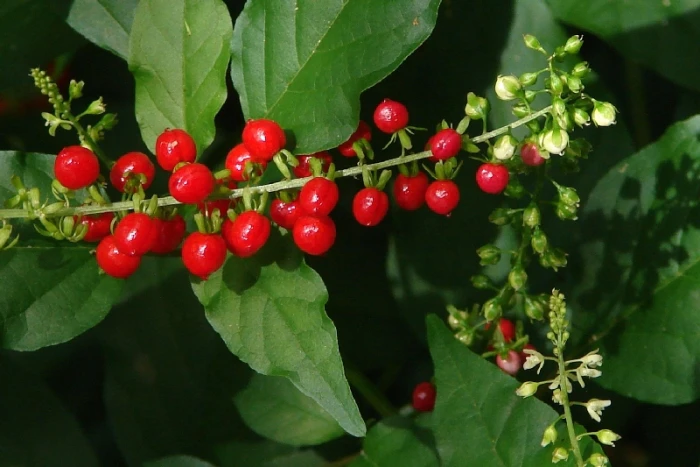Rougeplant
(Rivina humilis)
Rougeplant (Rivina humilis)
/
/

Tatters
CC BY 2.0
Image By:
Tatters
Recorded By:
Copyright:
CC BY 2.0
Copyright Notice:
Photo by: Tatters | License Type: CC BY 2.0 | License URL: https://creativecommons.org/licenses/by/2.0/ | Uploader: Tatters | Publisher: Flickr |




















































Estimated Native Range
Climate Requirements for San Benito, Texas
| This Plant | Your Site | Plant Suitability for Your Location | ||
|---|---|---|---|---|
| • Precipitation | 1" - 182" | 27" | Your precipitation may be insufficient for this plant. Irrigate N" / year. | Irrigate N" / year |
| • High Temp. | 61°F - 109°F | 94°F | Your summer temperatures are normal for this plant. | Excellent |
| • Low Temp. | 15°F - 91°F | 49°F | Your winter temperatures are normal for this plant | Excellent |
This plant should grow well at your location with about N inches per year (Y minutes per month) of irrigation.
Summary
Rivina humilis, commonly known as Rougeplant, is a semi-deciduous perennial herb or shrub native to the understory of forests, thickets, and open areas in the southeastern United States, Mexico, Central America, South America, and the Caribbean. It typically grows erect and vine-like, reaching a height of 0.4–2 m (1.3–6.6 ft) with a sprawling habit. The leaves are soft and lanceolate, and the plant produces small, inconspicuous flowers that can range from white or green to pink or purplish, blooming throughout the year in its native habitat. The fruit is a glossy, bright red berry 2.5–5 mm (0.098–0.197 in) in diameter, which adds to its ornamental value.
Rougeplant is valued for its ability to thrive in shaded conditions, making it an excellent choice for shade gardens, underplanting in tropical and subtropical landscapes, and as a groundcover. It is also popular as a houseplant or in greenhouses due to its tolerance of low light conditions. In cultivation, Rivina humilis prefers well-drained soil with organic matter and can tolerate a range of moisture conditions, though it does best with consistent moisture. While it requires less than partial sun and is tolerant of full shade, it will produce more berries in brighter light. Gardeners should be aware of its potential invasiveness outside its native range, as it can spread aggressively in suitable climates.CC BY-SA 4.0
Rougeplant is valued for its ability to thrive in shaded conditions, making it an excellent choice for shade gardens, underplanting in tropical and subtropical landscapes, and as a groundcover. It is also popular as a houseplant or in greenhouses due to its tolerance of low light conditions. In cultivation, Rivina humilis prefers well-drained soil with organic matter and can tolerate a range of moisture conditions, though it does best with consistent moisture. While it requires less than partial sun and is tolerant of full shade, it will produce more berries in brighter light. Gardeners should be aware of its potential invasiveness outside its native range, as it can spread aggressively in suitable climates.CC BY-SA 4.0
Plant Description
- Plant Type: Herb
- Height: 4-3 feet
- Width: 1-2 feet
- Growth Rate: Moderate
- Flower Color: Pink, White
- Flowering Season: Spring, Summer, Fall
- Leaf Retention: Semi-Deciduous
Growth Requirements
- Sun: Part Shade, Full Shade, Full Sun
- Water: Medium
- Drainage: Medium
Common Uses
Bird Garden, Butterfly Garden, Deer Resistant, Low Maintenance, Potted Plant, Rock Garden, Salt Tolerant, Showy Flowers
Natural Habitat
Native to the understory of forests, thickets, and open areas in the southeastern United States, Mexico, Central America, South America, and the Caribbean
Other Names
Common Names: Coralberry, Pigeonberry, Turkeyberry, Bloodberry, Baby Peppers, Bloodberry, Bloedbessie, Coralito, Sminkbär, 珊瑚珠
Scientific Names: Rivina humilis, Rivina laevis, Rivina humilis var. humilis, Rivina brasiliensis, Phytolacca latbenia, Rivina purpurascens, Rivina humilis var. glabra, Rivina humilis var. canescens, Rivina tinctaria
GBIF Accepted Name: Rivina humilis L.